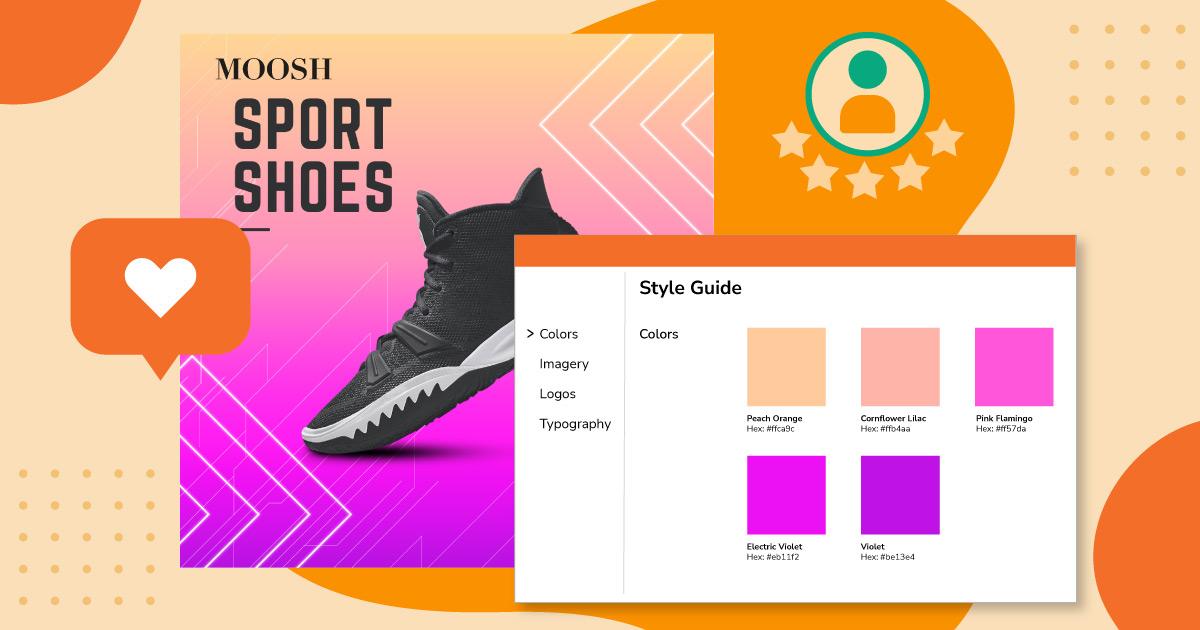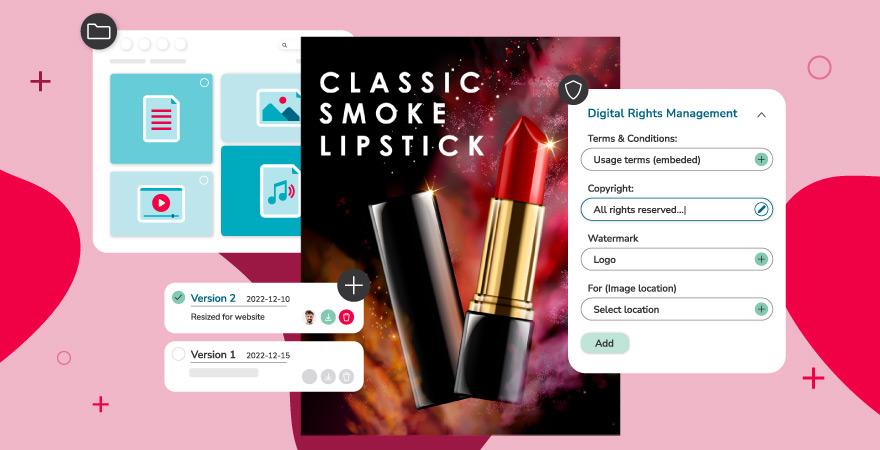Brand management 101: Defined, explained, and fully explored

Brand management definition
Brand management involves maintaining and enhancing a brand’s image, reputation, awareness, and equity across channels. It encompasses everything from defining and building brand identity to influencing how customers experience the brand online, in-store, and everything in between.
Brand management is achieved through strategic usage of brand elements — such as logos, colors, imagery, messaging, and tone — to build recognition and trust in the market.
A strong brand strategy and management approach shape brand perception and ultimately drive customer loyalty.
In short, brand management ensures your messaging, visuals, and experience remain consistent and impactful across all channels.
The importance of effective brand management
Effective brand management helps your company stand out in a crowded marketplace. A consistent and recognizable brand builds trust, increases awareness, and drives loyalty.
By aligning all marketing efforts, visuals, and customer experiences with your brand’s mission and values, you help customers form lasting emotional connections. Whether a shopper encounters your brand through a digital ad, retail display, or customer service interaction, strategic brand management ensures every touchpoint reinforces your identity.
Better brand recognition
Consistent messaging and visual identity make your brand easier to remember and trust.
Stronger customer loyalty
Repeated positive interactions help build long-term relationships that keep customers coming back.
Competitive advantage
A clearly positioned brand differentiates you in the marketplace and attracts more attention.

Key components of brand management
Whether you’re exploring ‘what is brand management’ for the first time or refining your brand architecture, it’s important to understand the fundamentals. Here are three essential pillars of brand management:
Brand equity
Brand equity is the perceived value of your brand in the minds of customers. It includes brand awareness, customer loyalty, brand association, and reputation. When managed well, strong brand equity enhances pricing power, drives repeat business and supports long-term growth.
Neglecting brand reputation management or delivering inconsistent brand image experiences can damage your equity quickly. Building it, however, takes time, consistency, and trust.
Pro tip: Find out the difference between brand equity vs. brand value now.
Brand recognition
Brand recognition is how easily your brand is identified by visuals, sounds, or tone — even when your name isn’t present. From logos and colors to slogans and tone of copy, strong branding development helps customers connect emotionally with your brand.
Consistency is key. Using brand asset management tools and clear brand guidelines ensures that messaging and visuals stay uniform across platforms.
Brand loyalty
Brand loyalty is when customers consistently choose your brand over competitors. Loyal customers spend more, return more often, and are more likely to promote your brand to others. Creating emotional connections through meaningful experiences is crucial for building loyalty and advocacy.
What are the three C’s of brand management?
A helpful way to understand effective brand management is through the three C’s: Clarity, Consistency, and Connection. These foundational principles help ensure that your brand is not only recognized — but remembered and trusted.
- Clarity: Your brand needs to clearly communicate who you are, what you stand for, and why it matters. This includes your mission, values, voice, and visual identity. Without clarity, your audience may struggle to understand or relate to your brand.
- Consistency: Consistency is what builds recognition and trust over time. From your logo and tone to your website and customer service, every interaction should feel cohesive. Consistent brand management ensures that your message doesn’t shift based on the platform, department, or campaign.
- Connection: A strong brand builds emotional connection. It speaks to the values and needs of your audience, creates memorable experiences, and inspires loyalty. Whether it’s a compelling brand story or thoughtful customer engagement, connection turns attention into advocacy.
Together, the three C’s help create a brand that not only stands out — but stands for something.
Who needs brand management?
Brand management isn’t just for global corporations or household names — it’s essential for any organization that wants to build recognition, earn trust, and create meaningful customer relationships.
Whether you’re a fast-growing startup, a creative agency, or a multinational company, your brand is one of your most valuable assets. Managing it well ensures that your visuals, messaging, and experiences are aligned across every touchpoint.
Organizations that benefit from brand management include:
- Startups looking to establish credibility and stand out early
- Mid-size companies scaling their presence across channels and markets
- Enterprise organizations managing multiple products, teams, or regions that require a unified identity
- Nonprofits working to build community and communicate their mission clearly
- Retailers and e-commerce brands aiming to deliver consistent experiences both online and in person
- Agencies and creative teams supporting multiple clients or campaigns with distinct brand voices
No matter the size or sector, any organization that wants to influence how it’s perceived — and maintain that perception consistently — needs brand management to guide the process.
What is a brand manager?
A brand manager is responsible for overseeing how a brand is perceived by its audience. They ensure that every element of a brand — from its messaging and visual identity to customer experience — is aligned, consistent, and strategically managed.
Brand managers often work cross-functionally, collaborating with marketing, creative, product, and sales teams. Their job is to make sure the brand stays recognizable, relevant, and trusted over time.
Typical responsibilities of a brand manager include:
- Developing and maintaining brand guidelines
- Creating and executing brand campaigns
- Managing brand voice and messaging
- Overseeing visual identity and digital assets
- Monitoring brand performance and perception
- Ensuring alignment across global or distributed teams
Modern brand managers also work closely with tools like digital asset management (DAM) platforms to maintain control over branding elements at scale.
Learn more: Top brand manager skills that make all the difference
Why use a digital asset management system for brand management
Modern brands require robust brand management software. With digital asset management (DAM) software, organizations can centralize content, control access, and improve collaboration. It’s a cornerstone of strategic brand management — especially for businesses scaling across multiple regions or channels.
A strong platform supports everything from asset organization to enforcing brand mgmt strategies, ensuring consistent rollout of campaigns and visuals.
With DAM software, you can speed up workflows, reduce content duplication, and gain insights into what works — while keeping your brand protected.
Five effective brand management strategies
Recognizable brands all have something in common — they have solid brand management strategies in place. Here are the five brand management best practices and branding strategies to follow.
1. Create a unique brand identity
Your brand development process should start with defining your mission and values — a brand positioning statement can help. Create a cohesive visual identity with a logo, color palette, fonts, and imagery that reflect your brand personality. The ability to reliable find and access these materials is essential.
Next, establish your brand voice — how your brand sounds in written and spoken communication. Whether you’re launching a product or writing website copy, branding management ensures that everything aligns with your identity.
And, don’t forget your brand story, a compelling narrative that highlights your origins, purpose, and vision. This helps set you apart and makes your brand more relatable.
However, it’s not enough to simply create your brand elements. You’ll also need somewhere to manage and share them from, too.

2. Centralize brand management with DAM software
Organizations looking to scale brand consistency across channels and markets need a digital asset management (DAM) platform. DAM platforms centralize all brand and content controls, digital assets, and style guides into one centralized and tidy source of truth.
DAM platforms come with the following brand management tools:
- Version control: Ensure everyone is always using the latest approved content
- Digital rights management (DRM): Track, manage, and protect licensed and copyrighted content from one place
- Content creation tools: Enable anyone to create on-brand content using approved templates
- Brand style guides: Provide easy access to brand guidelines for internal or external stakeholders
- DAM workflows: Scale and templatize content production in your digital asset library
- Brand portals: Curate content where teams can transform and deliver assets on demand
- Expiration dates: Remove content from circulation automatically on a specific date
- User permissions: Give your content the right level of visibility and access
Look for DAM platforms like Canto that include all-in-one online proofing software within the DAM platform, streamlining proofing, versioning, and approval in one place.

Centralizing your content in a DAM platform also boosts productivity. Since files all live in one place and are easily searchable, time spent finding assets is reduced and repetitive work eliminated. Many DAM solutions use metadata to organize content but modern DAM solutions also include auto-tagging, AI Visual Search, visual similarity search, and AI facial recognition for easy content retrieval. DAM solutions that are leveraging are all that AI has to offer also include sorting and metadata suggestion features, like Canto’s AI Library Assistant.
DAM software integrates with creative tools like Adobe Creative Cloud and Canva, bringing your brand files right into your existing toolkit.
Finally, a DAM solution allows for better analysis of content performance, helping you understand what branding strategies work, and what needs to change.
3. Maintain brand consistency across all marketing channels
Whether you’re managing your website, social media, email, or print ads, brand consistency is non-negotiable. Use a centralized calendar and DAM software’s style guides and brand templates to ensure your team delivers on-brand content across all platforms.
Brand templates are the fastest way to bring branded content to market without stretching creative services or third party spend. Products like Canto Brand Studio are great choices for scaling brand content output.

Additionally, implementing cross-channel alignment prevents brand confusion and strengthens brand recognition over time.
This is especially important for global or distributed teams — clear communication, access to brand-approved assets, and regular updates to your style guides are essential for scalable brand implementation services.
4. Prioritize customer experience
Customers remember how you make them feel. That’s why prioritizing experience is a core part of brand management in marketing.
Collect feedback, tailor content based on preferences, and deliver fast, mobile-optimized interactions across all channels. A DAM feature designed for image optimization and delivery, like Canto’s Media Publisher, improves the customer experience by ensuring content is always perfectly sized and fast to load.

Additionally, high-quality customer service and personalized communication reinforce loyalty and promote brand advocacy.
AI-powered chatbots, responsive support, and self-service options are also great options to keep in mind for maintaining an accessible and responsive customer journey.
5. Focus on loyalty-building programs
Consistency in value delivery helps build trust — and brand loyalty. Develop loyalty programs that reward repeat customers with points, discounts, or exclusive offers. Use customer insights to refine and personalize these programs.
Also, build community through social media, events, or exclusive content. Encourage customers to share their experiences and become brand evangelists — loyal fans who recommend your products organically.

Brand management in action: Glossier vs. Ikea
Two very different companies — Glossier, a direct-to-consumer beauty brand, and IKEA, a global home furnishings giant — demonstrate how brand management drives consistency, connection, and growth across business models.
Glossier built its brand around minimalism, digital intimacy, and community. From its clean packaging and pink hues to its conversational tone on social media, every element of the Glossier experience is carefully designed to reinforce its identity. The brand management strategy centers on emotional connection and user-generated storytelling, ensuring that its values are felt across digital and in-person touchpoints. Despite being a relatively young company, Glossier’s commitment to brand consistency has helped it grow a highly loyal customer base.
IKEA, on the other hand, focuses on accessibility, functionality, and affordability at a global scale. From its bold blue-and-yellow visuals to its do-it-yourself assembly experience, IKEA’s brand is immediately recognizable. Every store layout, product catalog, and marketing campaign reinforces its promise of “democratic design.” IKEA’s brand management strategy ensures that the customer experience — from signage to support — feels familiar and on-brand, whether you’re shopping in Stockholm or San Francisco.
While their audiences and operations differ, both brands excel because they align strategy, visuals, and experience across all customer touch points — building trust, shaping perception, and driving loyalty. That’s effective brand management in action.
Why choose Canto for brand management
Canto is the leading digital asset management platform for growing brands. With intuitive brand management solutions, Canto gives you centralized control over assets, campaigns, and brand elements.
Canto includes everything from version history and user permissions to AI-powered search and unlimited branded portals. With integrated workflows, smart tagging, and real-time collaboration features, your brand stays aligned no matter how big your team grows.
Whether you’re refining your brand strategy management, managing global content, or streamlining approvals, Canto helps bring clarity, speed, and consistency to every part of your brand management process.

Brand management frequently asked questions
How can a brand effectively measure the impact of its brand management strategies on customer perceptions and business outcomes?
To assess the impact of brand management strategies, companies can track metrics such as customer churn and customer feedback, NPS score, review sites, social media engagement, and brand mentions.
How can a brand overcome common brand consistency challenges?
Overcoming challenges in maintaining brand consistency requires a digital asset management platform to centralize brand management, robust and accessible brand guidelines, and effective communication across all departments and partners.
How does brand management differ for service-oriented businesses compared to product-oriented businesses, and what unique strategies should service-oriented brands consider?
For service-oriented businesses, brand management focuses more on customer experience and service quality. Strategies include employee training to ensure consistent service delivery and leveraging customer testimonials to build trust and credibility.